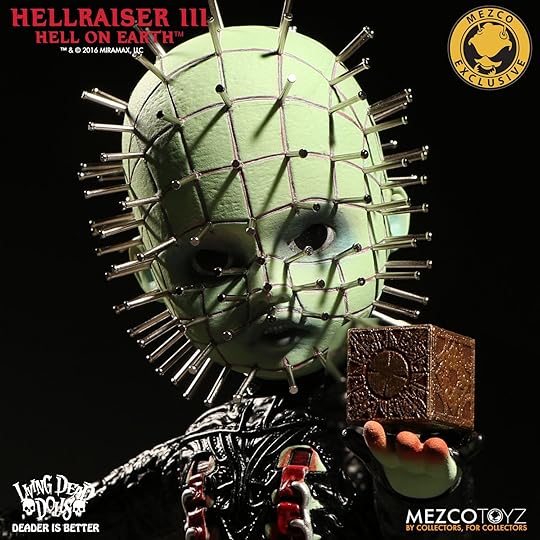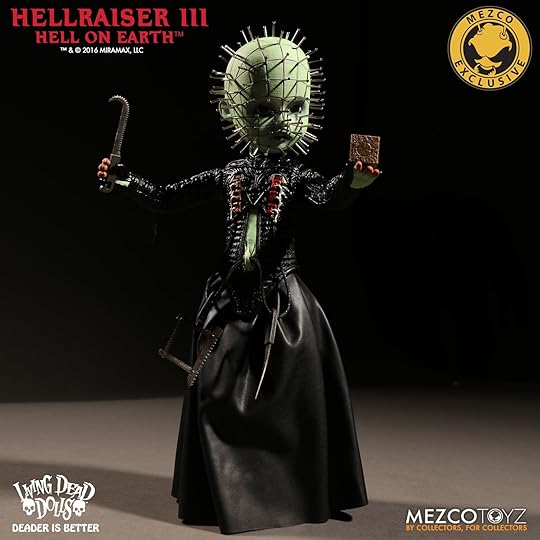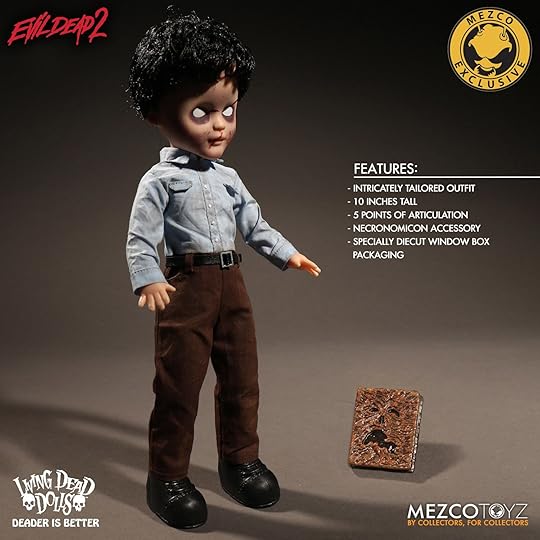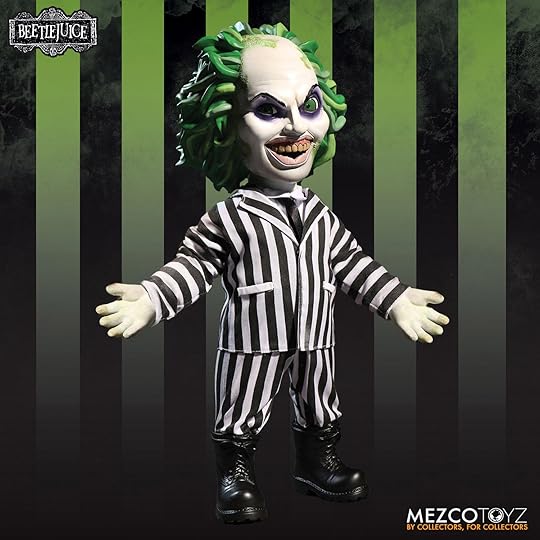Chris Hardwick's Blog, page 2153
February 27, 2017
SAMURAI JACK’s Return is Tougher, Meaner, and Undeniably Cool
With most of the recent spate of reboots and long-delayed continuations to TV shows, we talk about the final product in terms of how much is the same. It is as though any kind of change or differentiation from the original formula is egregious and scorn-worthy. With Adult Swim’s new 10-episode return to Samurai Jack, the differences are what will make it go down as one of the best animated miniseries of all time. Samurai Jack‘s original four-season run ended in 2004; both the makers of the show and the audience have changed in 13 years, and the show reflects that. It’s still Jack, but it’s decidedly grown up.
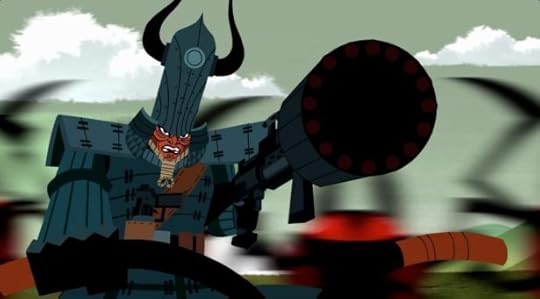
The story of Jack, the samurai prince from ancient times who is flung into the far future by the evil Aku, never wrapped up in 2004, so creator Genndy Tartakovsky is spending his limited series finally giving our stoic hero an ending. But rather than follow Jack on a series of mostly unrelated adventures that pit him against futuristic baddies, we get deeper focus on both Jack and how he’s lived since the original series ended. He’s not the same optimistic valiant warrior he once was; he’s been changed by his ordeal, and it seems never-ending.
We pick up 50 years in the future, but Jack hasn’t aged at all. He doesn’t know why exactly, just that it likely has to do with Aku’s magic. He’s embraced much more of the future world than ever before, riding a motorcycle, wearing modified Japanese armor, and wielding an arsenal of new weapons–both melee and projectile. The episode opens with an extended action sequence where the new Max Max-looking Jack takes on a cadre of robotic insects. It immediately hearkens back to Samurai Jack‘s first story, where he defends talking dogs against other robo-bugs. But here, there’s no one to defend; Aku’s evil has remained unchecked for so long that there’s nobody around who needs a hero. Why he’s still even bothering to fight is very much at the heart of this season, and the first episode certainly offers no answers.

Undoubtedly, Samurai Jack has aged very well in terms of its visuals. While keeping the basic Little Golden Books-style of artwork coupled with Spaghetti Western and manga references, everything seems much more mature, from the widescreen HD look of everything, to the way Jack is drawn slightly taller, slightly more angular. Even though he hasn’t aged the 50 years he’s spent in Aku’s future, his face shows the wear of ceaseless battle. All of this angst and torment has made the gorgeous open landscapes seem all the emptier, and Jack all the more singular in his quest.
The premiere episode is wall-to-wall action, and as with the previous seasons, Jack gets to take on a specialized, mouthy robot, which in this case is a sound-based warrior. One thing I’ve always loved about the show is how it allows for silence and ambient noise to be the only soundtrack for long stretches, and having a bad guy who uses sound as a weapon only punctuates how quiet the show is normally. It’s a brutal fight, and one that Jack might be too weary to win. Although it is just the first episode, we know this is going to be an uphill battle for the man who at one point seemed like the perfect, unstoppable warrior.
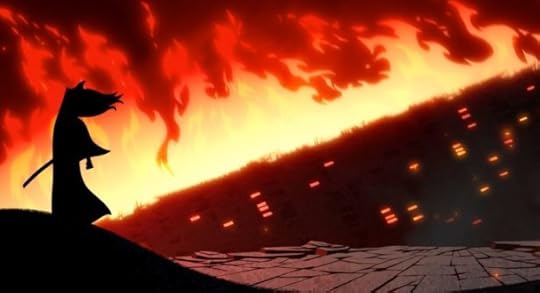
Pretty much, this is a gorgeous and exciting piece of action animation, maybe even more so than it had been in its Cartoon Network days. This feels like a story that deserves to be told, unlike some of the recent reboots. Fans of the series have wanted to see Jack finish his battle with Aku, and our patience has paid off. This is exactly the show I had hoped we’d get, with a harder edge than before but no less heart. I’m incredibly curious to see where the show goes and what Jack will have to endure. And with only 10 episodes, you can expect no filler.
Samurai Jack‘s final season premieres March 11 on Adult Swim. Let us know how high your excitement level is in the comments below! Until then, check out Genndy Tartakovsky’s list of 9 essential original series episodes to watch as a primer.
Images: Adult Swim
Kyle Anderson is the Associate Editor for Nerdist. He’s written the animation retrospectives Batman: Reanimated, X-Men: Reanimated, Cowboy Rebop, and Samurai reJacked. Follow him on Twitter!
Here are 11 anime that are perfect for beginners!
Adam Savage’s Checks Out GHOST IN THE SHELL Wonderfully Practical Robo-Geishas
We’ve been trying to scrub the visions of the creepy robo-geisha out of our minds ever since seeing the first footage of Ghost in the Shell late last year. We were certain that they were mostly some CGI creation that couldn’t actually get us in real life but it turns out that we were very, very wrong. Those terrifying robotic geisha faces do exist, but thankfully they are on the other side of the world at the Weta Workshop in New Zealand.

Recently, the Internet’s favorite undercover cosplayer Adam Savage took a trip for Tested.com to get a closer look at the Ghost in the Shell props and was amazed at the care and detail that went into the designs. Weta Workshop founder Richard Taylor explains that the robo-geisha face was modeled after one actress and then molds and various 3D printings were created in order to make the practical masks and other pieces that we see. One of the cooler aspects of the masks is how cleverly they were designed in regards to the actor’s comfort. Each was built with drawstring mechanisms in order to take them on and off quickly, and small fans were placed inside in order to keep the actors cool while wearing them. Air is brought in through the nostrils of the geisha’s face and vented through hidden exhaust in the hair portion of the mask.
What’s truly mind blowing is the animatronic geisha that opens her face like some sort of nightmare steampunk flower. And not just for it’s… *ahem*… “face value” because the details in the mask are astonishing. The inner workings of the face has functional clockwork-like gears and a level of deliberate wear-and-tear that gives the creature more depth. Additionally, Weta made each “face petal” attach via magnet so that mechanisms wouldn’t break if the face got bumped around too much.
You can see these animatronic nightmares for yourself in Ghost in the Shell, which hits theaters on March 31, 2017.
What’s your favorite part of these creatures? Let’s discuss in the comments below!
Images: Tested/Weta Workshop
New HELLRAISER, EVIL DEAD, and BEETLEJUICE Toys Are Horrifyingly Cute
By their very definition, horror films are intended to be scary. Even the horror/comedy mash ups usually have creatures that could be seen as terrifying. However, Mezco Toys’ latest offerings seem to be out to prove that even some of the most iconic names in horror can also be adorable.
Mezco has announced three new figures that should be familiar to any fan of horror movies from the ’80s and ’90s. But we’ve never seen them quite like this. First up is our old friend, Pinhead the Cenobite from Clive Barker’s Hellraiser films. Pinhead has been called “the Prince of Pain,” and he’s one of the most feared demons from his corner of Hell. Even after his latest makeover, that hasn’t changed!
That is the Hellraiser III: Hell on Earth Glow-In-The-Dark Pinhead, seen here holding the Lament Configuration as he tempts your soul with an eternity of pain and pleasure. But really, we’re more freaked out by his babyface features than anything else. Now that’s the stuff of nightmares! You can order your own here.
Next up is a version of Ash Williams from Evil Dead 2. In this case, it’s Deadite Ash, as envisioned for Mezco’s Living Dead Dolls.
That’s the kind of doll that can turn your home into an episode of The Twilight Zone. Note that the childlike Deadite Ash also comes with his own Necronomicon. It’s available here.
And finally, we’ve got Beetlejuice! And Mezco’s 15″ Mega Scale Beetlejuice figure may just be the scariest one of them all!
We’re not gonna say his name again, but you order your own here.
What do you think about Mezco’s newest additions? Scare up a response in the comment section below!
Images: Mezco Toys
SpaceX Will Attempt to Send Humans Around the Moon Next Year
Elon Musk and his company SpaceX are aiming to do something that NASA hasn’t done in the last 45 years: send humans on a trip around the moon. 1972’s Apollo 17 was the final moon mission for NASA, but in late 2018, SpaceX hopes to be the first private space industry company to successfully (and safely) send humans to the moon and back. The mission was announced earlier today on SpaceX’s website where it was revealed that two private individuals (and amateur astronauts) had already plunked down a substantial bit of moon money for the trip. The approximately week-long journey would take a long loop around the moon, out to 400,000 miles from Earth. But is the news just a bit of on-brand marketing or does this moonshot really have a chance of happening?
The folks over at ArsTechnica have some thoughts on that front. SpaceX is a business with designs on transporting humans to Mars, so a successful moon orbit will provide a strong proof of concept for current (and future) shareholders. The amount of the deposit made by the unnamed pair of hopeful astronauts was not divulged, but SpaceX’s previous business model aimed to use the funds from privatized space flights toward furthering their other research and development. The trip would also put the company’s existing spacecraft, like the mostly NASA-funded Dragon 2, which takes priority for shuttling astronauts to the International Space Station, and in-development vehicles, like the Falcon Heavy, funded internally and preparing for its first test launch this summer, to good use. That test flights for both vehicles will determine just how reasonable a late 2018 moonshot actually is.
Speaking of NASA, not only have they considered purchasing launch seats on Russian Soyuz rockets in 2019 as a back-up plan, they very recently began a study of adding crew to their first flight of the agency’s Space Launch System (SLS) rocket and the Orion spacecraft; that study should be completed by early spring. The planned Exploration Mission-1 would have a similar trajectory to SpaceX’s moon orbit trip.
So as NASA has allowed private industry to jump into low-Earth orbit while opting to focus on deep space exploration, some competition still exists in the areas closer to home. Technical hurdles certainly abound for SpaceX and other private companies, so some skepticism is healthy at the moment. Legal hurdles also loom, since SpaceX would need the U.S. government, and specifically the Federal Aviation Administration, to grant the company a license to carry out the mission. The risk, potential public relations nightmare, and tight time frame are all working against Musk at the moment. But so far it has seemed like Musk has the right stuff.
Would you like to book a trip around the moon with SpaceX in the future? (Duh, yes.) Be sure to let us know in the comments!
Image: SpaceX
A NIGHTMARE ON ELM STREET 3: DREAM WARRIORS Is The Best Horror Sequel Ever
Despite critical neglect, the horror movie genre has produced some undeniable cinema classics, the kind of movies that burrow into the popular subconscious in a deep way, and stay there. Movies like The Exorcist, Halloween, and The Shining are all still cultural touchstones, while many other popular films from their respective eras have faded from collective memory.
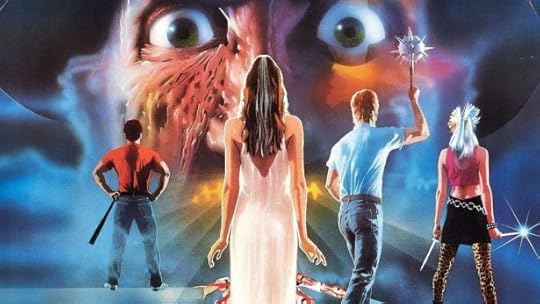
But as incredible as the horror genre can be, I’will be the first to admit that most horror movie sequels are usually pretty terrible. The previously mentioned movies like The Exorcist, Halloween and others like Poltergeist and Psycho and many others all had lackluster sequels. And before someone brings up Evil Dead 2, that movie is more like director Sam Raimi’s screwball remake of his original film than a true sequel. Sure, there are crappy sequels in other genres of film too, but not as much as there are for horror. Sci-fi has given us the likes of The Empire Strikes Back, Aliens and T2, while the superhero genre has The Dark Knight, Spider-Man 2 and X2.
But there is one great exception to the “all horror sequels must suck” theory – and that would be A Nightmare On Elm Street. 3: Dream Warriors. Released on February 27, 1987, the movie accomplished what few horror sequels ever do, which is elaborate and give greater depth to characters from the original film, introduce new characters we love just as much, and just expand the mythology in new and interesting ways. Dream Warriors does all of these things in spades. This could have merely been another poorly conceived follow up, since the second Nightmare film was exactly that.

New Line Cinema’s original A Nightmare On Elm Street, from writer/director Wes Craven, was a sleeper hit when it was released in the fall of 1984. The president of New Line Cinema, Bob Shaye, had put all of his money on this film and the future of his studio on the line, and if it had failed, New Line would have gone with it. But Shaye knew that Craven’s film was something special, and he was right.
The original Nightmare tapped into something going on in American culture, and it was a shot in the arm to a genre that was starting to get tired. All the elements for that first Nightmare worked. The casting of Robert Englund as Freddy Krueger, the score, and the subtext that the ’80s generation was paying for the sins of their Baby Boomer parents all helped to make A Nightmare on Elm Street a modern classic.

So of course New Line wanted a part 2 right away. Wes Craven wanted to move on, not really ever wanting a sequel to his film. Within a year of release, A Nightmare On Elm Street. 2: Freddy’s Revenge hit theaters, an early example of the quickie cash-grab sequel. The movie jettisoned a lot of the elements that made the original work. The “dream rules” from the original film had changed, at least somewhat, and the iconic musical score was gone. Tons of things happen that make no sense within the context of the plot.
Luckily, the producers were smart enough to have kept Robert Englund as Freddy, and he has several iconic moments in the movie. But even though the film made slightly more money at the box office than the original, everyone knew it was worse than the original. Nightmare 2 has a different reputation today as the “gayest horror movie ever made,” due to all the deliberate gay subtext put in by the writer, which makes it a hoot to watch now. But as a strict sequel to Craven’s original? It’s a total disappointment.

So when time came to go into production for part 3, Bob Shaye went back to the man who started it all, Wes Craven, to provide a bit of a course correction. He and his writing partner Bruce Wagner came up with a script that was vastly different from the final product, but the very basic elements of that script remain in the final film. The heroine of the first movie, Nancy Thompson (Heather Langenkamp) returns as an older, wise mentor figure to a new group of kids. The action of the movie now centers around a psychiatric hospital for troubled teens, and Freddy’s dream powers greatly expand from the first two movies. When Craven decided he wasn’t going to direct, the studio hired first time director Chuck Russell, and he a young writer named Frank Darabont re-wrote Craven’s original draft, while adding several new elements (not sure what became of that Darabont guy).
The most important new element that makes the film really stand out was the group of teens at the Westin Hills Institute. While all the kids kind of fit into typical Breakfast Club style classifications (the jock, the nerd, the criminal, the basket case) the movie finds a great cast to make the kids more than just stock stereotypes (among those kids was a very young Patricia Arquette, in one of her first roles). And then the story adds the genius element of giving the kids super powers in the dream world as a way of fighting Freddy, making it an almost superhero like story, a smart expansion of the original film’s concepts.

The film added other cool new elements as well, like giving Freddy Krueger a more sinister origin story than what we already knew. Dream Warriors added the backstory that Freddy’s mother was a nun who was trapped in the mental hospital one night with the worst of the mentally ill, and that her child, conceived by the brutal rape she endured by the inmates, ended up being Freddy — “the bastard son of 100 maniacs.” This disturbing new wrinkle to Freddy’s backstory was a genius addition to the mythology.
Freddy’s dream powers expanded (and so did the budget) giving the movie some truly memorable kills, like when Freddy turns the puppet-obsessed teen Phillip into a puppet himself. And the concept of the souls of the children Freddy murders become a part of him was also introduced in this movie, adding another element of now iconic Freddy visual imagery. No knock against Michael Myers and Jason Voorhees, but they just can’t do anything as cool as this.

Maybe most importantly, the idea of Freddy as a kind of “funny villain” really began with Dream Warriors. Sure, there were a few quips here and there in the first two movies, but this installment takes Freddy’s sick humor to an all-new level. Later entries in the series would overdo the humor, making Freddy into a horror version of Bugs Bunny, but Dream Warriors struck the perfect balance. Is there a more sickly funny moment in any horror film than when Freddy appears on a late night talk show and kills Zsa Zsa Gabor? The idea of Freddy Krueger as the stand up comic of horror icons really began with this film. It’s because of this movie that Freddy as we know him truly was born, at least in a greater pop culture sense.
Dream Warriors debuted at No. 1 at the box office during its opening weekend in 1987, and it eventually made $44 million at the domestic box office. That’s honestly not bad for a low budget horror film today, and thirty years ago, that kind of money was astronomical for something like this. A decent follow up film followed the next year, and Nightmare 4 made even more, but it was all downhill from there. None of the follow ups were as inventive or added any truly cool new elements to the Elm Street mythos like part 3 did, and by installment #6, the franchise was super tired. Luckily, Wes Craven returned to direct the final installment, New Nightmare, giving the series a proper ending. But Dream Warriors still remains the high point of all the sequels, and just horror sequels in general.

Thirty years on, most horror sequels have not learned the lesson that Dream Warriors tried to teach, and instead they keep making the mistake of usually just giving fans a re-hash of whatever worked in the first film, and expecting the audience to not care. I’d say one of the only modern horror franchises to really take a lesson from Dream Warriors is The Conjuring series, which chooses to focus on the human leads and give them a new supernatural case each time, instead of giving us a “greatest hits” version of the original film. When followinh up an unexpected horror hit, there should be a Blu-ray copy of A Nightmare on Elm 3: Dream Warriors on the desk of every movie executive as an example of how to make a horror sequel the right way.
—
Which Nightmare sequel is your favorite? Let us know down below in the comments.
Images: New Line Cinema
A Look Back at Bill Paxton’s Legacy
Over the weekend, Bill Paxton unexpectedly passed away after suffering from complications during surgery. He was 61 years old and his career spanned over 40 years, which included several iconic turns in film and television. How many actors can say that they’ve gone up against a Terminator, Aliens, and a Predator? Bill Paxton was the first to pull off that hat trick, and today’s Nerdist News is a special tribute to one of our favorite performers.
Join senior editor Dan Casey as we look back at Paxton’s incredible legacy, including the way that he encouraged director James Cameron to make The Terminator. It’s true: Paxton and Cameron had a friendship that went back several decades, and he was practically a good luck charm in several of Cameron’s biggest films. Would True Lies have been the same without Paxton’s hilarious fake secret agent? Would the modern day parts of Titanic have worked without Paxton’s driven treasure hunter, Brock Lovett? Paxton even joined Cameron on a real expedition to the sunken vessel, that’s how serious they were.
Paxton had several other memorable films as well, including Weird Science, Apollo 13, and Twister; a movie that led real storm chasers to create their own unique nod to Paxton. On television, Paxton’s legacy was also very impressive, with a starring turn in HBO’s Big Love, and the Hatfields & McCoys miniseries. Paxton even got to enter the Marvel Cinematic Universe in the first season of Agents of S.H.I.E.L.D. as renegade operative, John Garrett; who is still one of the best villains to have appeared in the MCU.
What’s your favorite Bill Paxton film or TV series? Share your memories with us in the comment section below.
THE ART OF MASS EFFECT: ANDROMEDA is Our Favorite Art Book on the Citadel (Exclusive)
With a little less than a month to go until we blast off into a new galaxy of RPG action with BioWare’s hotly anticipated Mass Effect: Andromeda, Dark Horse Comics is presenting a threat to our wallets even greater than the Geth and the Reapers combined: a brand new, 184-page, hardcover art book! Launching in conjunction with the game on March 21, 2017, The Art of Mass Effect: Andromeda is a fan’s dream come true with oodles of never-before-seen exclusive art featuring the game’s characters, enemies, weapons, and much more. And thanks to our pals in the Spectres, we have an exclusive first look inside the book, which you can see in our gallery below.
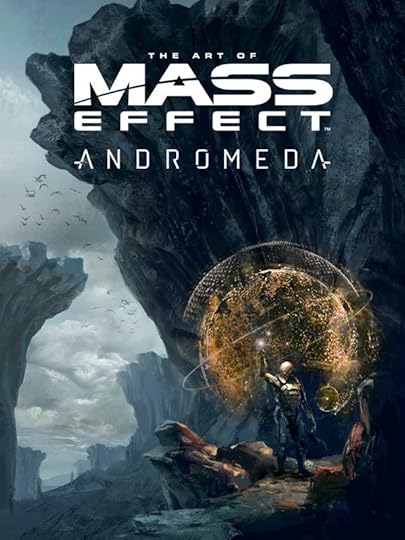
Here’s the official synopsis:
“The award-winning Mass Effect series captured the hearts and souls of gamers with its memorable characters, stunning visuals, and visceral combat! Now, the Mass Effect universe expands with Dark Horse’s The Art of Mass Effect: Andromeda—featuring exclusive art of the new game’s characters, arsenal, locations, vehicles, and more!”
The art book retails for $39.99 and is available from Dark Horse Comics and wherever fine books are sold. No word yet on whether it will include exclusive calibrations too or a foreword by Marauder Shields, but fingers crossed. In the meantime, take an exclusive sneak peek at the art book in our gallery below.
Are you excited for Mass Effect: Andromeda? Can any vehicle ever truly replace the Normandy?
Image: BioWare / Dark Horse Comics
Dan Casey is the senior editor of Nerdist and the author of books about Star Wars and the Avengers. Follow him on Twitter (@Osteoferocious) and ask him all about why he regrets leaving Kaidan for dead.
Breaking Down the Brilliant Way WHO FRAMED ROGER RABBIT Was Animated
There may never be a film that can compare to Who Framed Roger Rabbit in terms of animation. The CGI-filled, green-screen composites of modern movies are essentially realistic animation combined with live-action, but Roger Rabbit was really something special.
A new video by Kaptain Kristian and shared by Gizmodo dives deep into what went into making a film like Who Framed Roger Rabbit so unprecedented, and it has everything to do with detail. In the past, attempts to combine live action and animation worked well enough but there was always something about it that broke the proposed reality of the scenes. More often than not, this actually had to with details we weren’t even consciously noticing.
Turns out that the devil is in the details, and the filmmakers went absolutely nuts with them. For the animators, this meant a massive amount of time spent making sure eyelines met between live action characters and animated ones, as well as keeping perspective in mind when camera angles and actors shifted positions in each scene. The video even includes a memo from animation director Richard Williams to his staff about the importance of eyeline. 
Add to that the other flourishes we may have taken for granted like the specialized rigs constructed to compliment the hand-drawn animation with real world consequence. Things like actual lit cigars, a stream of real water, and even the simple interaction with a live-action character’s clothing all help to tie the animated characters to each scene and make a world filled with cartoons seem real.
And no scene represents this enormous attention to detail better than the one that inspired the term “Bumping the Lamp”. Kaptain Kristian breaks down how the sway of the light and the shadows cast in the room were painstakingly added to every frame making Roger feel like he’s with them in the scene. Just imagine how odd that scene would look if Roger were animated as a flat and brightly colored toon with no shading.
We already loved Who Framed Roger Rabbit for so many reasons and now, thanks to Kaptain Kristian, we can look at it with a whole new level of appreciation.
What’s your favorite part of Who Framed Roger Rabbit? Let’s discuss in the comments below!
Images: Kaptain Kristian | Disney
February 26, 2017
MOONLIGHT Won Best Picture… After LA LA LAND Won Best Picture (We’ll Explain)
So, here’s what happened.
Warren Beatty and Faye Dunaway, Oscar legends of the caliber you’d usually find reading off the year’s victor of the Best Picture Award, opened the final envelope of the night to find something rather suspicious: They were given the wrong card. Though vexed by the sight of Emma Stone’s name in what was meant to be a declaration of the Best Picture, and its association producers, Beatty proceeded to announce the accompanying movie, La La Land, as the big winner of the night. Naturally, the La La Land team took the stage to express their gratitude for the honor. That is, until they realized the mistake.
Midway through the group’s recitation of the usual thank-yous and expressions of the importance of dreaming big and going for the gold, La La Land producer Fred Berger got word from one of the Oscar ceremony’s techs that Beatty and Dunaway had read off the wrong title. In fact, the real winner of the Best Picture: Moonlight.
The mixup yielded an unsurprising amount of confusion and hullabaloo. Beatty reclaimed the mic to explain his perspective on the misstep, and Kimmel tried to smooth out the mayhem with a few jokes about giving both movies the Oscar. But in truth, the La La Land team, led by Berger, were incredibly gracious about the transference of the Oscar to its rightful owner.
The ultimate revelation that Moonlight was indeed the true winner of this year’s Best Picture Oscar inspired a great deal of elation, and surprise (and not only because of this particular episode of mayhem) from many of us watching at home. La La Land has long been projected as the favorite to win big this year, hitting the ceremony with a record-tying 14 nominations. Those rooting for Moonlight (including yours truly) recognized the story of a gay black child struggling to discover his own identity as he grows into manhood in an unforgiving neighborhood in Miami, as especially important to expression of tolerance, acceptance (and self-acceptance) and inclusion.
The only sustained tragedy of the incident is how the mix-up may overshadow the sociopolitical importance of Moonlight‘s win. But if we can get passed the “What?!” factor of it all, we can appreciate this victory as one of more than just a movie, but of an idea we need to prioritize now more than ever.
Image: A24
Oscars 2017 Enlist Emma Stone, Lin-Manuel Miranda, and More for Mean Tweets
Even those who don’t watch Jimmy Kimmel Live regularly know that one of the late night talk show’s most popular recurring bits is Celebrity Mean Tweets. If by some miraculous stroke you haven’t before seen the antic, it entails–unshockingly–a group of otherwise beloved famous people reading defamatory tweets of which they are the subject, penned by the internet’s legion of pseudo-anonymous trolls. Considering the popularity of the routine, it was no surprise that Jimmy Kimmel, the host of this year’s Academy Awards ceremony, enlisted a troupe of celebrity pals to read off the latest round of unflattering messages tweeted in their honor.
Kimmel brought 2017 Oscar nominees Natalie Portman, Emma Stone, Lin-Manuel Miranda, Ryan Gosling, and Casey Affleck, along with a round of likewise enamored Hollywood stars, to suffer through the bile of the ‘net once more. As per usual, one or two of the tweets in the bit are worthy of some hearty laughter–Miles Teller, as you’ll see in the video above, was the focus of a particularly clever (if not outrageously specific) barb. And it’s always encouraging to see celebs take their insults with stride–Jeff Bridges, to no one’s surprise, was happy to admit that he’s a casual pants-wearer at best.
Watch the video above and laugh along with (and yes, at) some of our favorite actors and actresses. They seem to be able to take it, after all, so we don’t have to feel too bad. And let us know which were your favorite mean tweets below!
Image: ABC
Chris Hardwick's Blog
- Chris Hardwick's profile
- 132 followers


